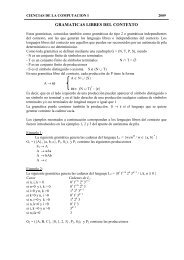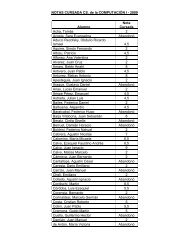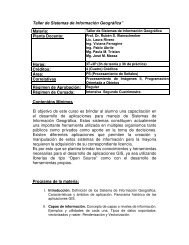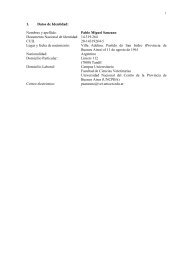Libro de Resúmenes / Book of Abstracts (Español/English)
Libro de Resúmenes / Book of Abstracts (Español/English)
Libro de Resúmenes / Book of Abstracts (Español/English)
Create successful ePaper yourself
Turn your PDF publications into a flip-book with our unique Google optimized e-Paper software.
Resumenes 20<br />
don<strong>de</strong> x = x(t) e y = y(t) representan los tamaños <strong>de</strong> las poblaciones <strong>de</strong><br />
presas y <strong>de</strong>predadores respectivamente para t > 0; los parámetros son<br />
6<br />
todos positivos, esto es, ( , , , , , ) + ℜ ∈<br />
= c p a q K r µ , y tienen diferentes<br />
significados biológicos.<br />
Multiples Hopf bifurcations in Gause type predator-prey<br />
mo<strong>de</strong>ls with nonmonotonic functional response.<br />
In this work, we show a method for <strong>de</strong>termine the number <strong>of</strong> limit<br />
cycles surrounding a equilibrium point that can bifurcate from a weak or<br />
fine focus on a family <strong>of</strong> predator prey mo<strong>de</strong>l <strong>de</strong>scribed by two-or<strong>de</strong>r<br />
differential equations systems.<br />
The characteristic <strong>of</strong> Gause type mo<strong>de</strong>ls [4] is that the predator<br />
numerical responses is a function <strong>of</strong> functional response and correspond to<br />
a compartimental mo<strong>de</strong>ls or mass action. The predator functional response<br />
or consumption rate, measures the prey change <strong>de</strong>nsity rate per predator<br />
and per time unit [13].<br />
The type IV functional response <strong>de</strong>scribe the effect <strong>of</strong> <strong>de</strong>fence group<br />
or aggregation [1, 4, 5, 6, 16, 17, 18], which is a form <strong>of</strong> antipredator<br />
qx<br />
behavior [12]. Most usual form is <strong>de</strong>scribed by the function h(<br />
x)<br />
= 2<br />
x + a<br />
[7, 8, 9, 10, 14, 15], <strong>de</strong>duced in [2], where x = x(t) indicates the prey<br />
population size.<br />
The <strong>de</strong>termination <strong>of</strong> the number <strong>of</strong> limit cycles surrounding a<br />
equilibrium point it is based in the calculus <strong>of</strong> Liapunov quantities [2, 3, 11].<br />
For obtain this quantities the system must be expressed in a normal form<br />
[3]. Denoting λ = ( λ1,<br />
λ2,......,<br />
λN<br />
) the parameters vector <strong>of</strong> system, we assume<br />
that the coefficients <strong>of</strong> the Taylor series at the origin for the component<br />
functions <strong>of</strong> system are polynomial in the components <strong>of</strong> l..<br />
The Liapunov quantities are computed when the trace <strong>of</strong> Jacobian<br />
(community) matrix evaluated at the equilibrium point is zero, that is, l1 =<br />
0. We <strong>de</strong>note for Λ = ( 0,<br />
λ2,......,<br />
λN<br />
) the vector <strong>of</strong> variable parameters that<br />
<strong>de</strong>termuines a hypersurface on the parameter space <strong>of</strong> system, such as the<br />
Liapunov quantities are functions <strong>of</strong> those parameter named li with i =<br />
2,3,....., N . Of this manner, those quantities are obtained as functions <strong>of</strong><br />
polynomial coefficients, which at once are <strong>de</strong>pen<strong>de</strong>nts <strong>of</strong> the parameters <strong>of</strong><br />
original system.<br />
This methodology it will be applied to the Gause type predator-prey<br />
mo<strong>de</strong>l <strong>de</strong>scribed by the ordinary differential equations system:<br />
3<br />
⎧dx<br />
x q x y<br />
⎪ = r(<br />
1 − ) x − 4<br />
⎪ dt k x + a<br />
X µ<br />
: ⎨<br />
3<br />
⎪dy<br />
⎛ p x ⎞<br />
=<br />
⎪ ⎜ − c ⎟ y<br />
4<br />
⎩ dt ⎝ x + a ⎠



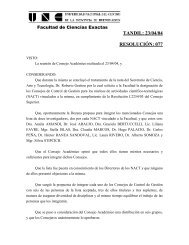
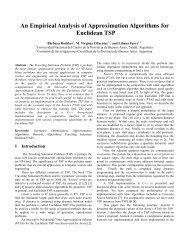
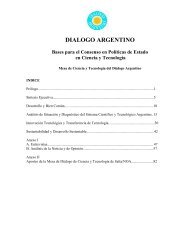


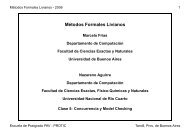
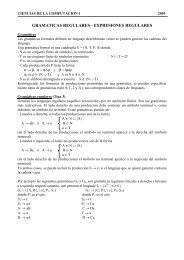

![Clase 13 [pdf]](https://img.yumpu.com/19616969/1/190x245/clase-13-pdf.jpg?quality=85)

